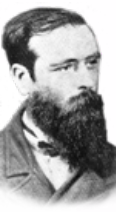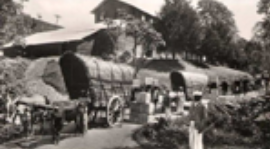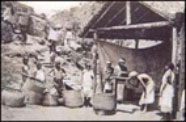Sri Lanka was formerly a British colony known as Ceylon, a name it kept for nearly a quarter-century after independence. It was during the British era that tea first began to be cultivated and manufactured here.
The story of Ceylon Tea begins with coffee. The coffee plant had already been found growing naturally among the approaches to the central hill country. Then British Governor Barnes threw the weight of official support behind large-scale cultivation. Land in the central hills was sold for a few pence an acre, official funds were dedicated to research and experiments in coffee-growing, planters and merchants were provided with incentives and support. Most important of all, Barnes provided the infrastructure – a network of roads, including the all-important trunk route from Kandy to Colombo – that enabled coffee-planters to get their produce to town, and then to market in England.
In the 1870s, coffee plantations were devastated by a fungal disease called Hemileia vastatrix or coffee rust, better known as "coffee leaf disease" or "coffee blight”. The death of the coffee industry marked the end of an era when most of the plantations on the island were dedicated to producing coffee beans. Planters experimented with cocoa and cinchona as alternative crops but failed due to an infestation of Heloplice antonie, so that in the 1870s virtually all the remaining coffee planters in Ceylon switched to the production and cultivation of tea.
 In 1824 a tea plant was brought to Ceylon by the British from China and was planted in the Royal Botanical Garden in Peradeniya for experimental purposes. Further experimental tea plants were brought from Assam and Calcutta in India to Peradeniya in 1839 through the East India Company and over the years that followed. In 1867, James Taylor marked the birth of the tea industry in Ceylon by starting a tea plantation in the Loolecondera estate in Kandy. He was only 17 when he came to Loolecondera, Sri Lanka.
In 1824 a tea plant was brought to Ceylon by the British from China and was planted in the Royal Botanical Garden in Peradeniya for experimental purposes. Further experimental tea plants were brought from Assam and Calcutta in India to Peradeniya in 1839 through the East India Company and over the years that followed. In 1867, James Taylor marked the birth of the tea industry in Ceylon by starting a tea plantation in the Loolecondera estate in Kandy. He was only 17 when he came to Loolecondera, Sri Lanka.
The original tea plantation was just 19 acres. In 1872 Taylor began operating a fully equipped tea factory on the grounds of the Loolecondera estate and that year the first sale of Loolecondera tea was made in Kandy. In 1873, the first shipment of Ceylon tea, a consignment of some 23 lb (10 kg), arrived in London. Soon enough plantations surrounding Loolecondera, including Hope, Rookwood and Mooloya to the east and Le Vallon and Stellenberg to the south, began switching over to tea and were among the first tea estates to be established on the island.
 Tea production in Ceylon increased dramatically in the 1880s and by 1888 the area under cultivation exceeded that of coffee, growing to nearly 400,000 acres in 1899. The only Ceylonese planter to venture in to tea production at the early stage was Charles Henry de Soysa. British figures such as Henry Randolph Trafford arrived in Ceylon and bought coffee estates in places such as Poyston, near Kandy, in 1880, which was the centre of the coffee culture of Ceylon at the time. Although Trafford knew little about coffee, he had considerable knowledge of tea cultivation and is considered one of the pioneer tea planters in Ceylon. By 1883, Trafford was the resident manager of numerous estates in the area that were switching over to tea production. By the late 1880s, almost all the coffee plantations in Ceylon had been converted to tea. Similarly, coffee stores rapidly converted to tea factories in order to meet increasing demand. Tea processing technology rapidly developed in the 1880s, following on from the manufacture of the first "Sirocco" tea drier by Samuel Cleland Davidson in 1877 and the manufacture of the first tea rolling machine by John Walker & Co in 1880—essential technologies that made realizing commercial tea production a reality. This realization was confirmed in 1884 with the construction of the Central Tea Factory on Fairyland Estate (Pedro) in Nuwara Eliya. As tea production in Ceylon progressed, new factories were constructed and innovative methods of mechanization introduced from England. Marshall, Sons & Co. of Gainsborough in Lincolnshire, the Tangyes Machine Company of Birmingham, and Davidson & Co. of Belfast supplied the new tea factories with machinery, a function they continue to perform to the present.
Tea production in Ceylon increased dramatically in the 1880s and by 1888 the area under cultivation exceeded that of coffee, growing to nearly 400,000 acres in 1899. The only Ceylonese planter to venture in to tea production at the early stage was Charles Henry de Soysa. British figures such as Henry Randolph Trafford arrived in Ceylon and bought coffee estates in places such as Poyston, near Kandy, in 1880, which was the centre of the coffee culture of Ceylon at the time. Although Trafford knew little about coffee, he had considerable knowledge of tea cultivation and is considered one of the pioneer tea planters in Ceylon. By 1883, Trafford was the resident manager of numerous estates in the area that were switching over to tea production. By the late 1880s, almost all the coffee plantations in Ceylon had been converted to tea. Similarly, coffee stores rapidly converted to tea factories in order to meet increasing demand. Tea processing technology rapidly developed in the 1880s, following on from the manufacture of the first "Sirocco" tea drier by Samuel Cleland Davidson in 1877 and the manufacture of the first tea rolling machine by John Walker & Co in 1880—essential technologies that made realizing commercial tea production a reality. This realization was confirmed in 1884 with the construction of the Central Tea Factory on Fairyland Estate (Pedro) in Nuwara Eliya. As tea production in Ceylon progressed, new factories were constructed and innovative methods of mechanization introduced from England. Marshall, Sons & Co. of Gainsborough in Lincolnshire, the Tangyes Machine Company of Birmingham, and Davidson & Co. of Belfast supplied the new tea factories with machinery, a function they continue to perform to the present.
 The Planters Association of Ceylon was established in 1854 and in 1915 Thomas Amarasuriya became the first Ceylonese to be appointed as Chairman of the Planters' Association. Tea was increasingly sold at auction as its popularity grew. The first public Colombo Auction was held on the premises of M/s Somerville and Company Limited on 30 July 1883, under the auspices of the Ceylon Chamber of Commerce. One million tea packets were sold at the Chicago World's Fair in 1893. That same year the tea netted a record price of £36.15 per lb at the London Tea Auctions. In 1894 the Ceylon Tea Traders Association was formed and today virtually all tea produced in Sri Lanka is sold at the auction supervised by this association and the Ceylon Chamber of Commerce. In 1896 the Colombo Brokers' Association was formed. In 1925 the Tea Research Institute was established in Ceylon to conduct research into maximizing yields and methods of production. By 1927 tea production in the country exceeded 100,000 metric tons. A 1934 law prohibited the export of poor quality tea. The Ceylon Tea Propaganda Board was formed in 1932.
The Planters Association of Ceylon was established in 1854 and in 1915 Thomas Amarasuriya became the first Ceylonese to be appointed as Chairman of the Planters' Association. Tea was increasingly sold at auction as its popularity grew. The first public Colombo Auction was held on the premises of M/s Somerville and Company Limited on 30 July 1883, under the auspices of the Ceylon Chamber of Commerce. One million tea packets were sold at the Chicago World's Fair in 1893. That same year the tea netted a record price of £36.15 per lb at the London Tea Auctions. In 1894 the Ceylon Tea Traders Association was formed and today virtually all tea produced in Sri Lanka is sold at the auction supervised by this association and the Ceylon Chamber of Commerce. In 1896 the Colombo Brokers' Association was formed. In 1925 the Tea Research Institute was established in Ceylon to conduct research into maximizing yields and methods of production. By 1927 tea production in the country exceeded 100,000 metric tons. A 1934 law prohibited the export of poor quality tea. The Ceylon Tea Propaganda Board was formed in 1932.
In 1938 the Tea Research Institute commenced work on vegetative propagation at St. Coombs Estate in Talawakele, and by 1940 it had developed a biological control (a parasitic wasp, Macrosentus homonae) to suppress the Tea Tortrix caterpillar, which had threatened the tea crop. In 1941 the first Ceylonese tea broking house, M/s Pieris & Abeywardena, was established. On October 1, 1951, an export duty on tea was introduced and in 1955 the first clonal tea fields began cultivation. On June 1, 1959, Ad Valorem Tax was introduced for teas sold at the Colombo auctions.
By the 1960s, Sri Lanka's total tea production and exports exceeded 200,000 metric tons per year and in 1965 Sri Lanka became the world's largest tea exporter for the first time. In 1963, the production and exports of Instant Teas was introduced, and in 1966 the first International Tea Convention was held to commemorate 100 years of the tea industry in Sri Lanka. During the 1971–1972 periods, the government of Sri Lanka nationalized estates owned by Sri Lankan and British companies, taking over some 502 privately held tea, rubber and coconut estates, and in 1975 it nationalized the Rupee and Sterling companies. Land reform in Sri Lanka meant that no cultivator was allowed to own more than 50 acres for any purpose. In 1976, the Sri Lanka Tea Board was founded as were such other bodies as the Janatha Estate Development Board (JEDB), Sri Lanka State Plantation Corporation (SLSPC) and the Tea Small Holdings Development Authority (TSHDA) to supervise the estates thus appropriated by the state.
Sri Lanka was the official supplier of tea at the 1980 Moscow Summer Olympic Games, in 1982 at the 12th Commonwealth Games in Brisbane and again in 1987 at Expo 88 in Australia. In 1981, the country began importing teas for blending and re-exports and in 1982 commenced the production and export of green tea. In 1983, the CTC teas method was introduced. In 1992–1993 many of the government-owned tea estates which had been nationalized in the early 1970s were privatized.
Tea from Ceylon gained the reputation of being the finest in the world, and tea exports became the mainstay of the colonial economy. Housewives and restaurateurs across the globe grew familiar with the name of the country, learning that its appearance on a tin or packet reliably guaranteed the quality of the tea inside.
When the country changed its name to Sri Lanka in 1972, its premier industry was faced with a knotty problem. Ceylon was not only the former name of the country; it was also one of the world’s leading brands, familiar to consumers’ world over – a brand the industry had been actively promoting and investing in since the early 1930s. Abandoning it would deliver a setback from which there could be no easy recovery. And the cost of promoting and establishing an unfamiliar new brand – ‘Sri Lanka Tea’ – would be exorbitant.
Though opposed by some who demanded a complete break with the colonial past and a new start for the country, industry leaders managed to persuade the socialist government then in power to permit the continued use of the name Ceylon to refer to the country’s most famous product. Tea from Sri Lanka would still be marketed as Ceylon Tea; a priceless world brand had been saved.